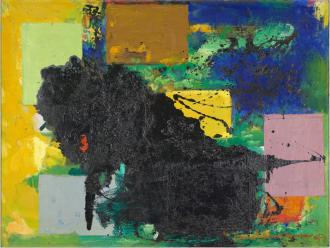Hans Hofmann is an artist revered by many, but rarely loved. His best known work, anchored in European theory, is the pinnacle of American academic abstraction. Energetic in brushwork and bright in primary color, it is among the best of the art of the 1950s that might have been ascendent in this country. That is, had the demigods Pollock, Rothko and de Kooning not sprung forth whole from the brows of the Olympian critics Clement Greenberg and Harold Rosenberg, blotting out the light of all others.
If Hofmann’s art fails to kindle equal passion, it is nevertheless challenging intellectually, full of visual puzzles and formal experiments. That is one reason it makes sense that a university — specifically the UC Berkeley Art Museum and Pacific Film Archive — has mounted the major exhibition “Hans Hofmann: The Nature of Abstraction.”
Another is that Hofmann, who taught at Berkeley for a spell and died in 1966, left a choice selection — the largest body of his art held by any institution — to the museum. The exhibition, which opened this week and runs through July 21, includes many of those paintings. Seen together, they amount to a detailed visual chronology.
New York’s Museum of Modern Art once mounted a show called “Hans Hofmann and His Students.” It included 51 top artists. Frank Stella, who never took a class with the master, has said he became a painter as “a Hofmann student without knowing that I was one.”
Take those scholastic facts as clues to the exhibition. Lucinda Barnes, who retired in 2016 as the Berkeley museum’s curator emerita, has devoted her research efforts in the years since to unraveling Hofmann’s artistic twists and turns. His development, as well as the progression of the exhibition and its accompanying catalog, read a lot like a textbook of modern art. There are lessons here, even when the work does not quite engage us emotionally.
Hofmann eventually landed upon what are called his “color plane abstractions,” the works now considered his highest achievement, which end the exhibition. On the way, however, he tested and tasted his own approach to, for example, the work of Paul Cézanne in “Apples,” circa 1934. The Cézanne influence he disconcertingly combined with Fauvism in an untitled, circa 1942, work in the exhibition. He tried out cubism (“Still Life,” 1936) and versions of surrealism (in the Miró-like “Untitled July 20, 1945,” 1945, and in the more inventive “Exaltment,” 1947). He freely imitated Kandinsky and borrowed from Matisse.
One arresting picture from Hofmann’s long period of incubation, “The Wind” (1942), is a work made by dripping paint directly on the canvas, which strongly suggests the work of Jackson Pollock. An excellent catalog essay by Ellen G. Landau shows that the work was probably not an influence on, but a more-or-less parallel experiment to, Pollock’s famous method.
Though the path through the exhibition is long and weaving to Hofmann’s mature work of the 1950s and ’60s, the exercise serves its purpose. On the one hand, to be honest, it is a relief to settle into the groove he finally carved, which occupies the second half of the show. Our perseverance gets its reward.
More to the point, however, we arrive prepared to focus on details we might have missed in works that require sustained attention. Expressionist sweeps and slathers of paint share canvas space with strictly drawn quadrangles. The flat expanse is edged by careful detail, the broad field shot through with staccato brushstrokes. This is not a show to breeze through in less than 90 minutes, particularly for those of us who enter it as skeptics.
Even in these final galleries there are side excursions, directions the artist might have taken had he lived longer than his nearly 86 years. The impenetrable stained canvas of “Agrigento” (1961), like a few rough strokes across a sun-bleached wall. The sanguinary depths of “Rubasse (A Beautiful Variety of Rock Crystal)” (1963), connoting narrative and romance. These suggest two poles to which he never ultimately traveled.
The payoff, as it happens, are the works most widely recognized. They are our entry into a world of floating forms, where the rational and the rectangular assert themselves only intermittently amid a more fluid space. Where the borders of fields in “Indian Summer” (1959) remain ever in suspension between formation and dissolution, and “Morning Mist” (1958), the artist’s masterpiece, convinces us of the possibility of what he called “a mystic light, determined exclusively through painterly development.”
Where, even when the hard-edged rises to the surface in, say, “Auxerre” (1960), something less strictly defined quivers in the recesses behind.
“Hans Hofmann: The Nature of Abstraction”: 11 a.m.-7 p.m. Wednesday-Sunday. Through July 21. $11-$13; 18 and under free. UC Berkeley Art Museum and Pacific Film Archive, 2155 Center St., Berkeley. 510-642-0808. https://bampfa.org
